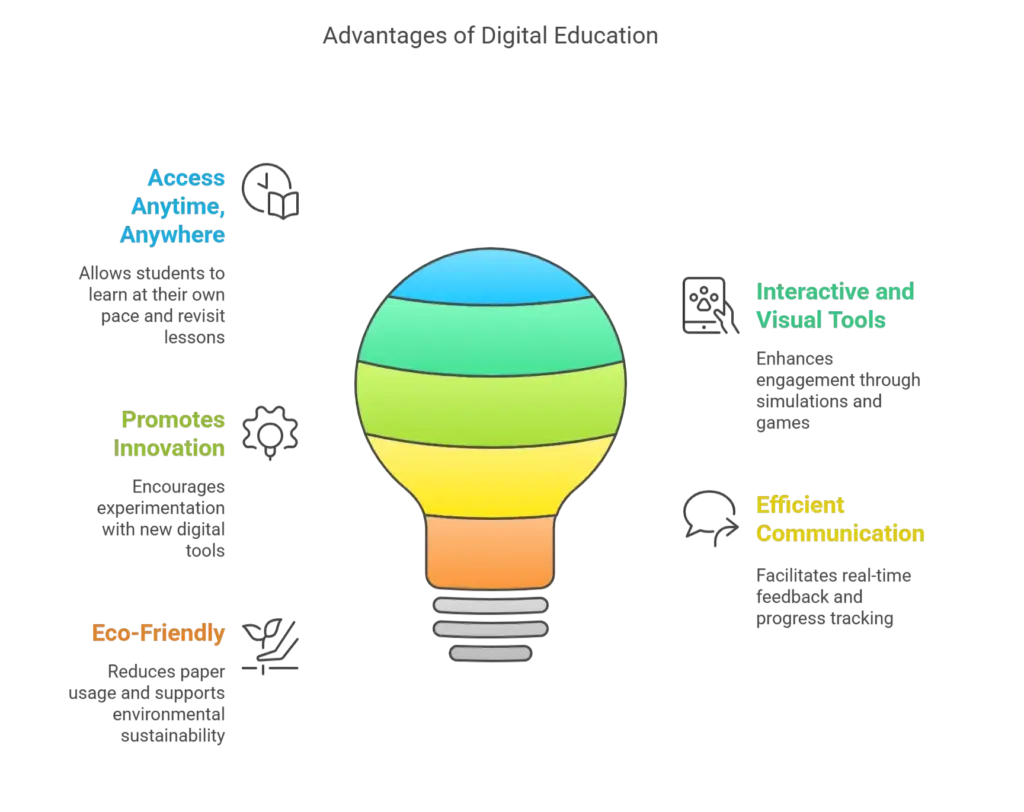"Technology can never replace great teachers, but technology in the hands of great teachers is transformational." — George Couros
We live in a digital-first world. From remote work and online banking to how we connect with friends and, of course, how we learn, technology is shaping everything. One of the most discussed topics today? The pros and cons of digital education.
Schools around the globe have been adopting digital tools, but is this shift toward digital learning a step forward, or are we losing something important in the process?
Let’s take an honest look at the pros and cons of digital education, how it's influencing classrooms, and how institutions like Epistemo Vikas Leadership School are striving for balance.
Why Digital Learning is Becoming Essential
By 2020, over 1.5 million new digitized jobs were projected globally.
The World Economic Forum estimates that 65% of today’s primary school children will grow into careers that don’t yet exist. Education must evolve to keep pace with this rapid transformation.
One promising path forward is a blended approach. One that embraces the benefits of digital technology while remaining aware of its challenges.
For a deeper look into the future of digital learning, explore this UNESCO article on digital learning.
What is a Digital Environment and What Are Its Pros and Cons?
Many ask, What is a digital environment, and what are its pros and cons? In education, it refers to a tech-driven ecosystem of tools and platforms that both empower and challenge traditional classroom experiences. A well-designed digital environment blends structure with flexibility, offering opportunities for innovation but also presenting hurdles such as screen fatigue and reduced face-to-face interaction.
That’s why schools with holistic education frameworks often combine digital tools with child-centric approaches to education that prioritize students’ needs and support more personalized, meaningful learning experiences.
The Advantages of Digital Education

Let’s start with what digital classrooms are getting right. The advantages of digital education are hard to ignore:
- Access Anytime, Anywhere: Students can learn at their own pace, revisit lessons, and explore subjects that spark their curiosity.
- Interactive and Visual Tools: Simulations, videos, and educational games make concepts easier to grasp and keep students engaged.
- Promotes Innovation: Teachers and students can experiment with new apps, digital collaboration tools, and project-based platforms.
- Efficient Communication: Parents, teachers, and students can stay connected, track progress, and share feedback in real-time.
- Eco-Friendly: Less paper, fewer printouts. It's good for the environment and easier on school budgets.
When evaluating technology in the classroom, the pros and cons are best understood in the context of student engagement, resource access, and teaching flexibility versus reduced in-person interaction.
The digital learning advantages can transform how we teach and learn — if used mindfully.
The Disadvantages of Digital Technology for Students

Digital doesn’t always mean better. It brings challenges, too. Some key disadvantages of digital technology for students include:
- Shorter Attention Spans: With distractions just a click away, focus can take a hit.
- Reduced Human Interaction: Virtual classrooms lack face-to-face mentorship, spontaneous discussions, and emotional support.
- Inequitable Access: Not every student has access to high-speed internet or personal devices.
- Academic Dishonesty: The ease of copying or cheating in digital assessments is a growing concern.
- Disadvantages of Digital Literacy: Not all students are digitally fluent, and misinformation can spread quickly.
- Exposure to Inappropriate Content: Without proper monitoring, students may access harmful content or addictive games.
Schools aiming to counter these challenges can benefit from adopting emotionally intelligent teaching methods that help students regulate screen stress and build meaningful connections.
These digital learning disadvantages reveal the importance of structure, monitoring, and guidance in any digital-first classroom.
Digital Transformation: Pros and Cons in Education
When we talk about the digital transformation pros and cons in education, the good side is that it makes learning easier to access and brings in new ideas. But there are also problems, like some teachers and students not being ready for the changes, and not everyone having the same chances to use technology. Schools that manage it well find a balance—using technology to help learning, without losing the human connection.
Digital Environment: Striking the Right Balance
A good digital learning environment needs both structure and flexibility. But simply adding technology isn’t enough. What matters is how it’s used. This is where some schools succeed, while others struggle.
For example, schools that depend too much on screens may lose the personal touch that students need. On the other hand, schools that avoid technology might leave students unprepared for today’s world.
That’s why understanding the technology and education pros and cons is so important. It helps schools create a balanced approach, blending the warmth of a classroom with the right digital tools.
A Case Study in Balance: Epistemo Vikas Leadership School

At Epistemo Vikas Leadership School, we don’t see digital tools as replacements — we see them as enhancements.
Our philosophy blends modern learning methods with core human values. Here’s how we approach technology in the classroom:
- Teachers are trained to use digital tools that enhance learning without replacing interaction.
- Students work on digital projects but also engage in group discussions and value-based sessions.
- Parents are encouraged to be part of the journey, with regular insights into their child's digital habits and academic growth.
Whether it's smart classrooms, hybrid projects, or ethical use of social media, we strive to maintain the right mix.
Because to us, digital education is not just about screens — it’s about creating responsible, curious, and collaborative learners.
Final Thoughts: Technology Is a Tool, Not a Solution
Brian Greenberg said it best:
"Technology is important, but it’s just the means to an end. The real magic is in giving great educators freedom and license in how school works."
So, what’s the verdict on the pros and cons of digital education?
The truth is — it depends. On how it’s used, monitored, balanced, and taught. Used well, it opens doors. Used poorly, it can widen gaps.
Understanding the pros and cons of technology on education helps stakeholders make informed decisions about its integration in schools.
At Epistemo, we’re committed to walking this fine line — using technology not to replace the classroom but to amplify its reach.
Want to Learn More About Our Digital Learning Philosophy?



Discover how we combine the best of both worlds — digital innovation and holistic education — to raise the next generation of learners.
FAQs On Pros and Cons of Digital Education
What is digital education?
Digital education means learning with digital tools like online platforms, apps, and multimedia content. Virtual, blended, and tech-integrated classrooms. Not just screens – how, when, and where learning happens.
What are the benefits of digital learning in schools?
Digital learning is more flexible and engaging. Students can revisit lessons, use interactive tools, and access more resources. Teachers can personalise instruction, and parents are better informed.
What are the disadvantages of digital education?
Digital education can lead to screen fatigue, reduced face-to-face interaction, and unequal access. Some students struggle without direct support, and if not managed well, too much tech can dilute core learning experiences.
What are the pros and cons of technology in teaching?
Technology in teaching opens up dynamic learning opportunities, interactive lessons, and instant feedback. But it can also lead to over-reliance on screens, less personal connection, and unequal access to tools. The key is to use tech to enhance, not replace, great teaching.
What are the pros and cons of e-learning?
E-learning is flexible, convenient, and provides access to more resources. Students can learn at their own pace. But it can also cause screen fatigue, isolation, and lack of hands-on experience. Not all learners thrive in a digital-only environment.
What are the 5 disadvantages of technology for students?
Shorter attention spans, Less social interaction, Unequal access to devices/internet, Risk of academic dishonesty, More exposure to inappropriate or distracting content
These show why guidance and structure are key in digital classrooms.
How do teachers keep students engaged in online classes?
Variety is key—interactive tools, live discussions, breakout rooms, polls, and real-world projects. Teachers also need to be empathetic and check in regularly. It’s not just the content – it’s the connection that keeps students engaged.


